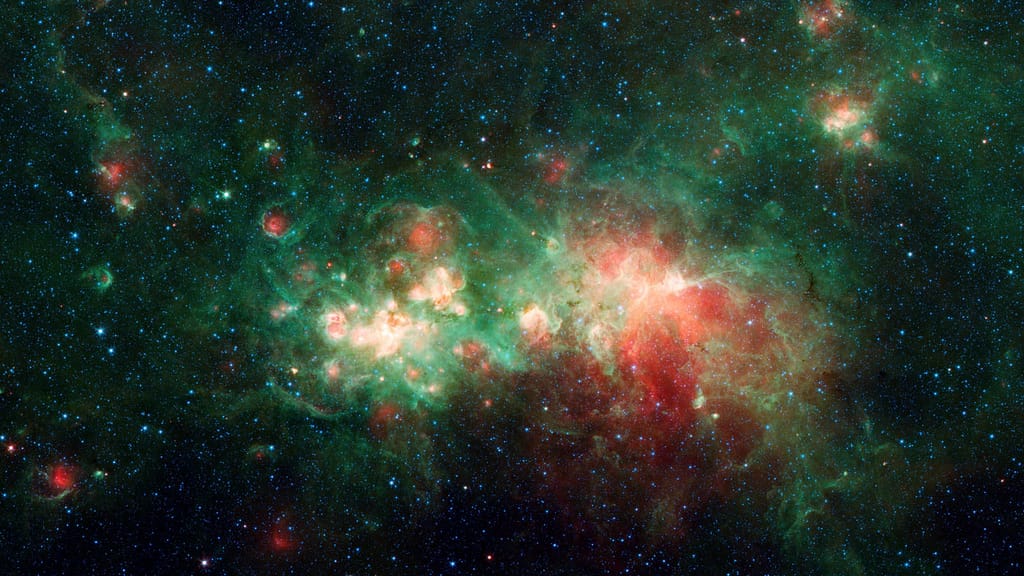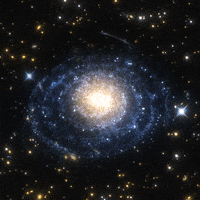How big this universe?
The size of the universe is a topic of ongoing scientific research and exploration. Based on our current understanding, the observable universe, which is the portion of the universe that we can see and study, is estimated to be about 93 billion light-years in diameter. This estimation takes into account the expansion of space over time.

However, it’s important to note that the universe may be much larger than the observable universe. The true size of the entire universe, including the parts beyond our observable reach, is still unknown. Some cosmological theories, such as inflationary cosmology, suggest that the universe may be much larger and could extend beyond what we can currently observe.
Moreover, the concept of “size” becomes somewhat complex when discussing the universe. The universe is not like a finite object with a specific boundary; instead, it is often described as infinite or spatially flat. It’s a vast expanse of space that may extend infinitely in all directions.
In summary, while the observable universe is estimated to be about 93 billion light-years in diameter, the true size of the entire universe, including its unobservable regions, remains a topic of active scientific investigation.
How many universes?
The concept of multiple universes is a topic of speculation and exploration in theoretical physics and cosmology. There are various theories and hypotheses that suggest the possibility of multiple universes, often referred to as a “multiverse.” However, it’s important to note that these ideas are still highly speculative and not yet conclusively proven.
Here are a few examples of the proposed multiverse concepts:
1. Bubble Multiverse: This idea stems from the theory of cosmic inflation, which suggests that shortly after the Big Bang, the universe underwent a rapid expansion. In this scenario, our universe would be just one of many “bubbles” within a larger multiverse, each with its own physical laws and properties.
2. Many-Worlds Interpretation: This interpretation of quantum mechanics proposes that every quantum event results in the branching of multiple universes. According to this idea, every possible outcome of a quantum event actually occurs in different parallel universes.
3. String Theory and M-Theory: These theoretical frameworks suggest the existence of multiple dimensions beyond the four we experience (three spatial dimensions and one time dimension). Within string theory and its extension, M-theory, it is hypothesized that there could be a vast landscape of universes or “branes” with different physical properties.
It’s important to note that while these ideas are fascinating, they are still speculative and lack direct experimental evidence. Scientists continue to explore and investigate these concepts through mathematical models, theoretical frameworks, and observations to better understand the nature of our universe and the possibility of other universes or a multiverse.
What are Galaxies?
Galaxies are vast systems of stars, gas, dust, and other celestial objects held together by gravity. They are the building blocks of the universe and come in a variety of shapes, sizes, and compositions. Let’s explore some key aspects of galaxies:
1. Types of Galaxies: There are three main types of galaxies:
a. Spiral Galaxies: These galaxies have a flattened, rotating disk-like structure with spiral arms. Our own Milky Way galaxy is a spiral galaxy.
b. Elliptical Galaxies: Elliptical galaxies are more spheroidal or elliptical in shape and lack the distinct spiral arms. They often contain older stars and have less ongoing star formation compared to spiral galaxies.
c. Irregular Galaxies: Irregular galaxies have no specific shape or structure and are characterized by their irregular appearance. They can vary greatly in size and often exhibit active star formation.
2. Galaxy Sizes: Galaxies can range in size from small dwarf galaxies containing a few million stars to massive giant galaxies with hundreds of billions of stars. The size of a galaxy is often related to its type, with elliptical galaxies tending to be larger than spiral galaxies.
3. Galaxy Clusters and Superclusters: Galaxies are not distributed randomly but are often found in groups called galaxy clusters. These clusters can contain anywhere from a few to thousands of galaxies bound together by gravity. Superclusters are even larger structures that consist of multiple galaxy clusters.
4. Active Galaxies and Quasars: Some galaxies exhibit active galactic nuclei (AGN), which are regions at the centers of galaxies that emit intense radiation. Quasars, for example, are extremely bright and distant objects powered by supermassive black holes at the centers of galaxies.
5. Evolution of Galaxies: Galaxies evolve over time through various processes such as mergers with other galaxies, star formation, and interactions with their environment. Through these processes, galaxies can change their structure, composition, and even trigger bursts of star formation.
Understanding galaxies and their properties is a fundamental aspect of cosmology and astrophysics. Scientists study galaxies to gain insights into the formation and evolution of the universe, the distribution of matter, and the underlying physical processes at work in these vast cosmic structures.
Understanding our Milky Way galaxy:
The Milky Way galaxy is the home galaxy of our solar system and is a spiral galaxy. Here are some key aspects to help understand our Milky Way:
1. Structure: The Milky Way has a distinct disk-like structure with spiral arms that radiate from a central bulge. It consists of several components:
a. Galactic Center: At the heart of the Milky Way lies a dense region called the Galactic Center. It is believed to contain a supermassive black hole called Sagittarius A*.
b. Galactic Bulge: The central region of the Milky Way, known as the bulge, is a dense concentration of stars and stellar remnants.
c. Galactic Disk: The disk is a flattened region that contains most of the stars, gas, and dust in the galaxy. The Sun resides within this disk.
d. Spiral Arms: The Milky Way has several spiral arms, including the Sagittarius Arm (where the Sun is located) and the Perseus Arm. These arms contain clusters of stars, nebulae, and gas clouds.
2. Size and Mass: The Milky Way is estimated to have a diameter of about 100,000 to 150,000 light-years and a thickness of about 1,000 light-years. Its mass is estimated to be roughly 1.5 trillion times the mass of the Sun.
3. Stellar Population: The Milky Way is home to billions of stars. These stars vary in age, size, and composition. The central regions tend to have older stars, while the spiral arms have regions of active star formation.
4. Halo and Stellar Halo: Surrounding the disk of the Milky Way is a spherical region called the halo. The halo contains sparse populations of stars, globular clusters, and dark matter. The stellar halo refers to the diffuse distribution of stars in this region.
5. Galactic Rotation: The Milky Way rotates, with stars and gas orbiting the galactic center. The rotation speed varies with distance from the center, which led to the discovery of dark matter—an invisible form of matter that provides additional gravitational pull.
6. Milky Way’s Neighborhood: The Milky Way is part of a group of galaxies known as the Local Group. The Local Group contains more than 54 known galaxies, including the Andromeda Galaxy (M31), the Triangulum Galaxy (M33), and numerous dwarf galaxies.
Studying the Milky Way provides insights into galactic evolution, the formation of stars and planetary systems, and the distribution of matter in the universe. Scientists use various techniques, including observations across different wavelengths of light, computer simulations, and surveys to map and understand the structure and dynamics of our galaxy.
The Milky Way galaxy is the home galaxy of our solar system and is a spiral galaxy. Here are some key aspects to help understand our Milky Way:
1. Structure: The Milky Way has a distinct disk-like structure with spiral arms that radiate from a central bulge. It consists of several components:
a. Galactic Center: At the heart of the Milky Way lies a dense region called the Galactic Center. It is believed to contain a supermassive black hole called Sagittarius A*.
b. Galactic Bulge: The central region of the Milky Way, known as the bulge, is a dense concentration of stars and stellar remnants.
c. Galactic Disk: The disk is a flattened region that contains most of the stars, gas, and dust in the galaxy. The Sun resides within this disk.
d. Spiral Arms: The Milky Way has several spiral arms, including the Sagittarius Arm (where the Sun is located) and the Perseus Arm. These arms contain clusters of stars, nebulae, and gas clouds.
2. Size and Mass: The Milky Way is estimated to have a diameter of about 100,000 to 150,000 light-years and a thickness of about 1,000 light-years. Its mass is estimated to be roughly 1.5 trillion times the mass of the Sun.
3. Stellar Population: The Milky Way is home to billions of stars. These stars vary in age, size, and composition. The central regions tend to have older stars, while the spiral arms have regions of active star formation.
4. Halo and Stellar Halo: Surrounding the disk of the Milky Way is a spherical region called the halo. The halo contains sparse populations of stars, globular clusters, and dark matter. The stellar halo refers to the diffuse distribution of stars in this region.
5. Galactic Rotation: The Milky Way rotates, with stars and gas orbiting the galactic center. The rotation speed varies with distance from the center, which led to the discovery of dark matter—an invisible form of matter that provides additional gravitational pull.
6. Milky Way’s Neighborhood: The Milky Way is part of a group of galaxies known as the Local Group. The Local Group contains more than 54 known galaxies, including the Andromeda Galaxy (M31), the Triangulum Galaxy (M33), and numerous dwarf galaxies.
Studying the Milky Way provides insights into galactic evolution, the formation of stars and planetary systems, and the distribution of matter in the universe. Scientists use various techniques, including observations across different wavelengths of light, computer simulations, and surveys to map and understand the structure and dynamics of our galaxy.
Position of Earth we live in in this universe:
The Earth is located within the Milky Way galaxy, specifically in one of its spiral arms called the Orion Arm or Local Spur. The exact position of our solar system within the Milky Way is approximately 27,000 light-years from the galactic center.
To provide some context, if you imagine the Milky Way as a disk-shaped structure, our solar system is located about two-thirds of the way out from the center towards the edge of the disk. The specific coordinates used to describe the Earth’s position in the Milky Way are typically given in terms of galactic longitude and latitude.
In terms of the larger scale of the universe, the Milky Way is just one of billions of galaxies. It is estimated that there are over 100 billion galaxies in the observable universe. The Earth’s position within the universe is relatively small in scale, but it holds immense significance for us as it is the planet we call home.



